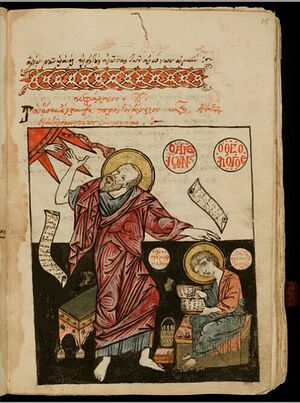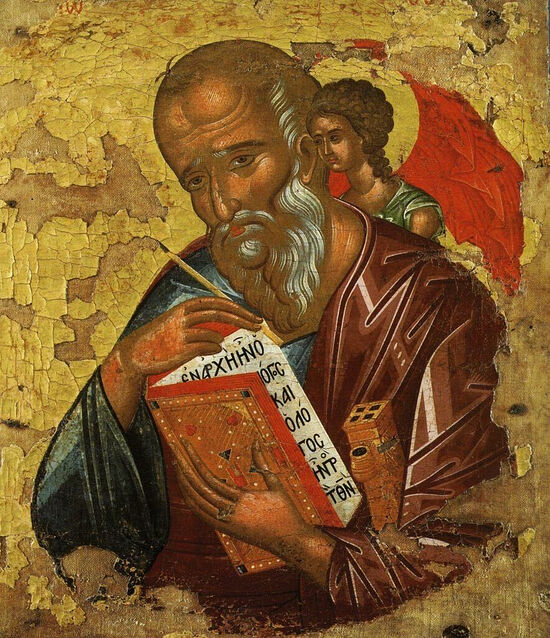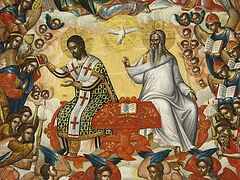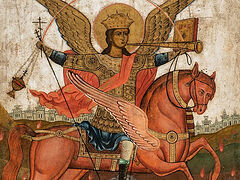Talk 2. Apocalypse as a Literary Genre
Methods of interpretation of the book of Revelation
Let us begin with the text of Revelation. Before we start reading, let’s examine what methods of interpretation ecclesiastical writers have used for Revelation.
There are four types of interpretation: preterist, historical, futuristic, and spiritual.
The preterist interpretation considers the events described in the book as relating exclusively to the time of the writing of the book.
The historical interpretation explains that the book depicts periods in the life of the Church.
The futuristic interpretation mainly focuses on the time of the last generation of people on Earth, when the apocalyptic prophecies will be fulfilled.
The spiritual (allegorical) interpretation says that the vision of St. John the Theologian is a prophecy that can relate to any era. The book is a revelation of general principles of Divine providence in history that are applicable to all times.
Of course, none of these methods of interpretation of Revelation are satisfactory in and of themselves. Our ecclesiastical interpreters use exegetical combinations, and we will follow their path.
***
Revelation 1:1 The Revelation of Jesus Christ, which God gave unto Him, to shew unto His servants things which must shortly come to pass; and He sent and signified it by His angel unto His servant John: 2 Who bare record of the word of God, and of the testimony of Jesus Christ, and of all things that he saw.
’Αποκάλυψις (Apokalipsis)—the first word of the book of Revelation. It appears as the title of the epistle only in the second century. It’s worth noting that, according to the opening phrase of the first verse, we are looking at the revelation of Jesus Christ, not St. John. The apostle simply has to pass on what Christ revealed to him.
What is the “revelation of Jesus Christ?” It can be understood in two ways.
1) The revelation of Christ, received by Him from the Father
But how can something be revealed to Christ if He Himself is God? The expression of Revelation about the revelation of Jesus Christ, which God gave unto Him, must be understood as referring to Christ according to His humanity. He spoke of Himself during His earthly life as not being omniscient (cf. Mk. 13:32), and receiving revelations from the Father (cf. Jn. 5:20). Here we are confronted with the mystery of the God-manhood of Christ, which we cannot fully understand.
Note that Christ preached in the name of the Father. The Antichrist will preach in his own name. He will be self-referential. During the course of our conversation, we will return to this idea several times.
2) A revelation about Jesus Christ, given to St. John by the Father.
That is, the fate of the Church and the world is revealed before St. John, and all of this is about Christ, about His economy of our salvation.
***
In verses 1-2, we see the “chain of revelation”: God the Father—Jesus Christ—an angel—St. John—other servants of God. This chain is at work in the first ten chapters of the book.
 Note that the revelation is sent through an angel. Later in the book, angels will appear in nearly every chapter. In this respect, Revelation is an angelic book.
Note that the revelation is sent through an angel. Later in the book, angels will appear in nearly every chapter. In this respect, Revelation is an angelic book.
The ultimate goal of revelation is “His servants,” as Christians are called here. In general, the expression “servant of God” is an honorary name for the Old Testament prophets and righteous ones. Those named so in Scripture are: Abraham, Moses, Jacob, Caleb and Joshua the son of Nun, David, Elijah, Isaiah, Job, and the prophets and apostles in general. St. John also emphatically refers to himself as the “His servant.”
All Christians are servants of God, and in a sense, prophets too. God has given the Church knowledge of things which must shortly come to pass. The truth is announced to us, and we are called to bear witness to it to the world in word and deed. In this consists our prophetic ministry.
This idea is repeated at the end of the book: An angel refers to the Church as a brotherhood of prophets, including St. John (cf. Rev. 22:9). A bridge is spread from the beginning to the end.
Since we are talking about the connectivity of the beginning and end of the book, we should say a few words about the composition of Revelation.
Composition. Chiasm
Revelation is written in a chiastic-concentric form. What does that mean?
We’re used to taking texts as a linear account of events and expect any story to have a sequential and distinct cause-and-effect chain. But in Revelation, the elements of the narrative are not arranged linearly one after another, but “concentrically.” Picture fragments are arranged symmetrically and equidistantly in pairs around the center of the story. The conceptual center, the culmination (and key to the whole work) is to be found not at the end, as a conclusion, but in the middle, as at the center of a circle.
This literary method can be found in many Biblical works, especially the poetic books (the Psalms, for example). Sometimes, an entire book is built using this method, sometimes one sentence or several. In Biblical studies, this is called “chiasm,” or “chiastic structure,” from the Greek letter “χ,” called “chi.” The letter illustrates this method graphically: Its cross shape has four ends in a concentric diagonal alignment. The point where the lines intersect is the conceptual center of the work. The ends of the straight lines are the rest of the material, “revolving” around the conceptual core of the narrative.
This layout of the book emphasizes not a sequential movement from beginning to end, but the special theological significance of the central chapters (11-13). The other sections are symmetrically arranged around them, as around an axis.
We can say that Revelation consists of a prologue and an epilogue with seven visions in the middle. The center is chapters 11-13.
***
To shew unto His servants things which must shortly come to pass.
The phrase which must shortly come to pass is taken from Daniel 2:28. There God reveals to King Nebuchadnezzar what shall be in the latter days. Here, God’s plan (“must”) and the specified soonness are emphasized.
What is meant by “shortly” (εν τάχει)? We are talking about the last time (the latter days), if to use the futuristic interpretation.
According to the commentary of St. Andrew of Caesarea, the word “shortly” is used here relative to the eternality of God. One day is with the Lord as a thousand years (2 Pt. 3:8).
That which is soon for God many not be soon for us. When we come across such designations in Scripture, we must understand that it is first of all a testimony that what is said will certainly be fulfilled.
Some understand “shortly” as a sign that the specified events have already begun to be fulfilled. But when will it end? Perhaps not soon.
Therefore, “shortly” should not be understood in the sense of a short term, but rather as “supra-time, which has power over time as its internal norm,” suggests Fr. Sergius Bulgakov.
And He sent—this is the aorist from σημαίνω—literally “gave a sign.” God communicates the revelation to St. John in the form of visions and symbols. There will be a great many of them further on.
Who bare record of the word of God, and of the testimony of Jesus Christ, and of all things that he saw.
What does Who bare record of the word of God, and of the testimony of Jesus Christ mean?
St. John bore witness to Christ by his preaching and his sufferings. Or another option: St. John “testified” (epistolary aorist, i.e. “he here testifies”) of this revelation of Jesus Christ, which is called here the word of God, and the testimony of Jesus Christ.
The word of God … and of all things that he saw, could be the same thing, meaning that the visions are some kind of Divine “word” or “message.” Or perhaps it refers to words and images: “heard and saw.” In Greek, “that he saw” is rendered as: όσα—“as much,” and είδεν—“saw.” That is, a possible translation would be: “as far as he saw.” As far as he examined, understood, and accommodated it—this is how much he transmits it.
What did St. John hear and see? We will talk about this in the next article.




